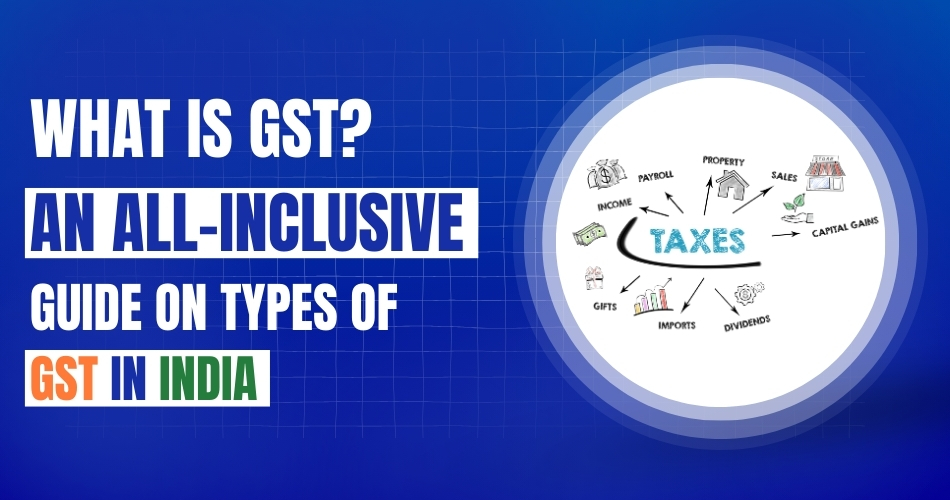GST is an abbreviation for Goods and Services Tax. It is a kind of value-added tax on the goods sold in the domestic market as well as services offered in the domestic market. A new tax in India was implemented on July 1, 2017. Therefore, GST has replaced the bouquet of indirect taxes otherwise associated with businesses such as VAT, excise duty, and service tax. The starting of GST was to ease tax procedures and to assure a unified national market.
Types of GST in India, Structure, Slabs of GST in India, and Specific Roles of CGST, SGST, and IGST are the contents of this article.
What is GST?
Before we move further into the structure of GST, it would be quite important to know what is GST, and what are its primary objectives. GST is basically an overall, destination-based tax applied at every value addition. Such a tax is charged at every point in the supply chain, from the producer to the final consumer, thus making the final consumer pay the tax.
How Many Types of GST Are There?
In the current context of India, four basic types of GST exist based on a transaction type and jurisdictional boundaries. These include:
CGST: Central Goods and Services Tax
SGST: State Goods and Services Tax
IGST: Integrated Goods and Services Tax
UTGST: Union Territory Goods and Services Tax
Each type has an important function in the structure of taxation, thus ensuring that each type of government receives its share of tax.
Structure of GST: A Deeper View
GST is so designed that tax credits are easily circulated within the supply chain. Perhaps one of the big pluses of GST is that it eliminates cascading. In the old tax regime, taxation was very sequential. Here, multiple taxes fall on an entity at different stages of the supply chain. GST has wiped out this burden by allowing seamless input tax credits.
What is the Full Form of CGST? What is the meaning?
CGST is the abbreviated form of the Central Goods and Services Tax. CGST is that central and state governments have jurisdiction over it. Therefore, a tax will be collected from goods and services. For example, if there is a seller who is a manufacturer of an article in Maharashtra, then he would collect SGST and CGST from a seller in his own state.
CGST is a central government tax and the revenues acquired from this tax will be used to fund the federal programs, infrastructure, defense, and many other things.
SGST Full Form and Explanation
The full form of SGST is State Goods and Services Tax. Like CGST, SGST is levied over intrastate supplies. However, it is collected by the state government. And this amount is supposed to provide the state revenue that will be used for funding schools, hospitals, roads, and many other things.
As for every intra-state transaction, the revenue from the tax is divided equally between the central and state governments as levied by the two CGST and SGST equally over all intra-state transactions.
What are CGST and SGST Cumulatively?
These form integrated taxation at the state level. Suppose, a product is carrying GST at 18% as the rate; that will be divided into 9% CGST and 9% SGST. Therefore, in this way, both the central governments receive their share of collection of tax without affecting the business or consumer at all.
IGST Full Form and Its Role
The abbreviation, IGST stands for Integrated Goods and Services Tax. IGST is charged on inter-state transactions and imports. For instance, assume a seller resident in Maharashtra who proposes to supply goods to a buyer located in Gujarat. The central government would then collect IGST on such a transaction that then transmits the collected tax to the state governments concerned in the transaction.
This is only a smooth process and ensures tax revenue splitting in equal proportions between states and the centre, while it also promotes easy inter-state trade.
UTGST: Special Case of Union Territories
Even though it is not as much spoken about, UTGST is as relevant in Union Territories as the other three. For instance, UTGST applies to Chandigarh, Andaman & Nicobar Islands, and Lakshadweep, among others. It is similar to the SGST except it has been drafted and designed with the knowledge that the Union Territories do not have the power over the state taxes.
Types of GST in India: Deep Analysis
Having elaborated on these basics, let us now understand the various types of GST in India. The understanding of each type has helped businesses comply much better with tax policies.
Central Goods and Services Tax (CGST)
CGST Central government levies on a supply made within the same state. This type of GST essentially finances the central government’s schemes and infrastructure. It follows the Central Goods and Services Act, 2017.
State Goods and Services Tax (SGST)
The amount collected here goes to the state government to provide funds for state-specific projects. It is a way of ensuring that the state reaps in all the economic activities taking place on its terrains. IGST is integrated with the Integrated Goods and Services Tax Act, 2017.
IGST is also one of the sources of revenue for inter-state trade and commerce. The amount of IGST is passed to the states, though it is collected by the central authority. IGST helps in the prevention of tax evasion. It makes inter-state deals easier as one rate of tax is given.
Union Territory Goods and Services Tax (UTGST)
Even though it is applied everywhere, UTGST seems to include Union Territories for balancing the GST towards not being in favor of States. It is almost the same as that of SGST but with modifications for Union Territories having different forms of governance.
Applicability and Scope: GST Slabs in India
The GST system follows a slab-based scale. Hence, India’s GST system retains various tax slabs to cater to every category of goods and services. The four major GST slabs in India are as under:
5% – This slab is to be reserved for essential goods and services so that the common man can easily bear the cost of living.
12% – This slab is moderately taxed and classifies products and services into standard goods.
18% – The slab applied 18% on the majority of products and services so that the government gets direct substantial income.
28% – Luxury as well as demerit goods will be attracted to this highest slab, like automobiles, tobacco and other consumer electronics.
Slab structure: In slab structure, incidence of taxation would be diffused across various sectors of the economy.
CGST vs SGST
Probably the most frequently asked question is regarding the CGST and SGST. While both – theoretically – are intrastate levies, the difference in principle lies in their revenues collection. One is collected by the central government, while the other is collected by the state government. These have been charged at the same rate, implying an equal share of the tax burden between these two authorities.
Conclusion: The Future of GST in India
It is much in the interest of trade as well as consumers to know about GST-its structure and types. As long as India’s economy will continue growing in the future, GST will ensure fair as well as equal taxation by holding the key to transparent and efficient taxation. Be it the full form of CGST, or the difference between CGST and SGST, or the importance of IGST, each feature of GST creates a single, all-inclusive, transparent, and efficient tax system.
For the future, businesses would need to keep themselves updated with GST slabs existing in India, the required compliances, and possible changes in the system.

